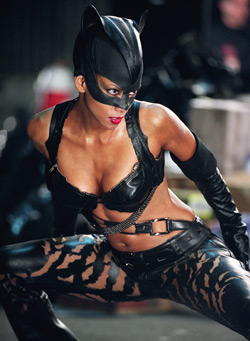in this film scene we can see how women in the clip are represented. It can be identified that both women are shown as powerful fighters in the clip as both women are accsesorised with weapons and look like they are in fight. the visousness in the clip shows how the woman poses a masculine fighting charectoristic which was not so popular in early days of cinema tv.Anaylise scene from kill
Sunday 30 September 2007
MIGRAIN
 M-Both films use tight clothing on main female characters.Both movies use fast paste sound as there are many fighting scences. bothe moovies are very fast paste there more to keep momentam the films tend to use many fast paste cut shots.
M-Both films use tight clothing on main female characters.Both movies use fast paste sound as there are many fighting scences. bothe moovies are very fast paste there more to keep momentam the films tend to use many fast paste cut shots.I-
Kill Bill-Miramax Films
Catwoman- Warner Brothers
G-
Both movies have a similar genre as bothe charectors in the movie use a basic story line. The genre can be seen as a Action/thriller/fantasy between both movies as there is a sense of these in both texts.
Both females are represented as heroes fighting against a villain following Propp’s theory.
In both movies men and women are the villains- challenging stereotypes.
A-
The target audince in both the movies is an similar age range with just a younger target market for catwomen. Kil Bill tends to appeall to a more mature age grouph as it has a coplicated story line.
I-
Both films follow a
Non Patriarchal,Feminist values, Capitalist- Kill Bill- Villain is wealthy Ideolgy.
N-
Kill Bill and Catwan Follow Todrovs Narrative structure
Wednesday 26 September 2007
Independent study proposal
The text I have chosen to base my question is on to famous Hollywood blockbusters ‘Catwomen’ released in august 2004 and ‘Kill Bill Volume 2’ released 2004. I have chosen these particular texts as they relate to my question and can be identified to the issues that I will be dealing with in my question. I have also chosen these particular movies as I have watched these movies before and therefore can identify key points effectively as well as watching the movies again during my study.
In my hypothesis I believe the study will leave me to a well-assessed two-sided argument of the question, which will show that women are progressing in films in present future. I also believe that I can use the key concepts very effectively in my study as the question can easily be related to theorist’s narrative genre etc.
I will also answer my question by using many internet resources available to research theorist such as Laura Mulvey and study the male gaze theory in depth to use in my study.
Sunday 23 September 2007
new title
Research- How are Women Represented in the Action Movie Genre? Empowered Female Role Models or Highly Sexualised Chicks with Guns?
What is Feminism? Feminism is the fight for equality for women, and has been a recognised philosophy for the last thirty years. Since the 70's there have been phenomenal changes in the roles of women in Western society. However there is still a lot to be done before the representation of women is completely accurate. The representation of women across all media tends to focus on the following: beauty, size/physique, sexuality, emotional (as opposed to intellectual) dealings and relationships (as opposed to independence/freedom). Laura Mulvey, regarded as one of the most prominent feminist film critics, is famously quoted as saying "narrative fiction film created images of women used for the gratification of men".
However, as times have changed so have women's roles in society, and accordingly their representation in the media.
Changes in Female Representation Media images still portray women as sex objects; as independent (but still sexy) career women; as doting mothers obsessed with food and clean football shorts. Women are still portrayed as objects to lust after; they are often the focus of the male gaze' ("Visual Pleasures and Narrative Cinema" Laura Mulvey), with camera effects, mise en scene and use of sound to accentuate their appearance. But the definition of attractiveness has changed. Images of women as dizzy blondes or mothers/nurturers have been replaced by a new breed. 50 years ago most males wanted a subservient doormat for a wife (which may explain the lack of empowered female characters; as opposed to damsels in distress/ femme fatales in older movies). Now men are looking for intelligent, confident, empowered, "ass-kicking babes", who manage to look perfect even after fifteen minute fights with chainsaw wielding robots/ flesh-eating zombies/ indestructible cyborgs.
Representation The changes in representation of women can be seen in the Terminator' trilogy. In Terminator I' Sarah Connor, the main female protagonist is portrayed as hysterical, screaming and in need of rescue. Terminator II' shows her as a strong, empowered female able to hold her own. The two main female characters in Terminator III' are Kate Brewster, another damsel in distress and the TX, a deadly but sexy killing machine who uses her sexuality as a weapon (e.g. inflating breasts to avert trouble from police). Both of the two cyborgs in Terminator', the Terminator himself (Arnold Schwarzenegger) and the female Terminator, the TX, are robots supposedly with no human feelings. However, the Terminator appears to have human characteristics, almost showing compassion and empathy, while the TX is portrayed as a bloodthirsty, evil, invincible killing machine.
by Charlotte Starlett


